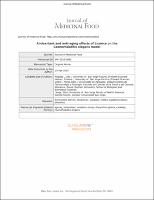Please use this identifier to cite or link to this item:
https://repositorio.usj.es/handle/123456789/1097
Full metadata record
| DC Field | Value | Language |
|---|---|---|
| dc.contributor.author | Reigada, Inés | - |
| dc.contributor.author | Moliner Langa, Ana Cristina | - |
| dc.contributor.author | Valero Gracia, Marta Sofía | - |
| dc.contributor.author | Weinkove, David | - |
| dc.contributor.author | Langa Morales, Elisa | - |
| dc.contributor.author | Gómez-Rincón, Carlota | - |
| dc.date.accessioned | 2024-02-01T14:12:02Z | - |
| dc.date.available | 2024-02-01T14:12:02Z | - |
| dc.date.issued | 2019-09-25 | - |
| dc.identifier.citation | Reigada I, Moliner C, Valero MS, Weinkove D, Langa E, Gómez Rincón C. Antioxidant and Antiaging Effects of Licorice on the Caenorhabditis elegans Model. J Med Food. 2020 Jan;23(1):72-78. doi: 10.1089/jmf.2019.0081. Epub 2019 Sep 25. PMID: 31545123. | en_US |
| dc.identifier.issn | 1557-7600 | en_US |
| dc.identifier.uri | https://repositorio.usj.es/handle/123456789/1097 | - |
| dc.description.abstract | The causative relationship between oxidative stress and aging remains controversial, but it is a fact that many of the pathologies of age-related diseases are associated with oxidative stress. Phytochemicals may reduce damage from oxidative stress; the intake of these through diet could represent a strategy to lessen their pathological consequences. The popular and widely consumed licorice (Glycyrrhiza glabra) is a rich source of potential antioxidants. The aim of this study was to investigate whether licorice increases the oxidative stress resistance and lifespan of the animal model Caenorhabditis elegans. Licorice roots ethanolic extract showed in vitro antioxidant activity, with an IC50 of 51.17 μg/mL using 2,2-diphenyl-1-picrylhydrazyl (DPPH) as free radical. C. elegans pretreated with licorice showed an increase of survival rate when exposed to the oxidant juglone, being this increase up to ∼33.56%. This pretreated population also showed an increase in lifespan of 14.28% at a concentration of 250 μg/mL. In conclusion, we suggest that licorice has a high antioxidant capability both in vitro and in vivo and that this activity may explain the observed extension of lifespan. | en_US |
| dc.format.extent | 7 | en_US |
| dc.format.mimetype | application/pdf | en_US |
| dc.language.iso | eng | en_US |
| dc.publisher | Mary Ann Liebert | en_US |
| dc.rights | Atribución 4.0 Internacional | * |
| dc.rights.uri | http://creativecommons.org/licenses/by/4.0/ | * |
| dc.subject | Caenorhabditis elegans | en_US |
| dc.subject | Glycyrrhiza glabra | en_US |
| dc.subject | Aging | en_US |
| dc.subject | Antioxidant | en_US |
| dc.subject | Catalase | en_US |
| dc.subject | Oxidative stress | en_US |
| dc.title | Antioxidant and Antiaging Effects of Licorice on the Caenorhabditis elegans Model (Versión aceptada) | en_US |
| dc.type | info:eu-repo/semantics/article | en_US |
| dc.relation.publisherversion | https://www.liebertpub.com/doi/abs/10.1089/jmf.2019.0081?journalCode=jmf | en_US |
| dc.identifier.publicationfirstpage | 72 | en_US |
| dc.identifier.publicationlastpage | 78 | en_US |
| dc.identifier.doi | 10.1089/jmf.2019.0081 | en_US |
| dc.rights.accessrights | info:eu-repo/semantics/restrictedAccess | en_US |
| Appears in Collections: | Artículos de revistas | |
Files in This Item:
| File | Description | Size | Format | |
|---|---|---|---|---|
| Antioxidant and Antiaging version aceptada.pdf | 603,35 kB | Adobe PDF |  View/Open |
This item is licensed under a Creative Commons License

